History and Development of Human Vaccines: Smallpox, Rabies, Tetanus, Polio, and Pertussis
VerifiedAdded on 2023/05/31
|6
|2152
|171
AI Summary
This article discusses the history, discovery, development, and methodology of human vaccines for smallpox, rabies, tetanus, polio, and pertussis. It explores the immune system responses and prevention of disease manifestations. The timely administration of approved vaccines is highly required to challenge the progression and establishment of contagious, acute, and chronic disease conditions.
Contribute Materials
Your contribution can guide someone’s learning journey. Share your
documents today.
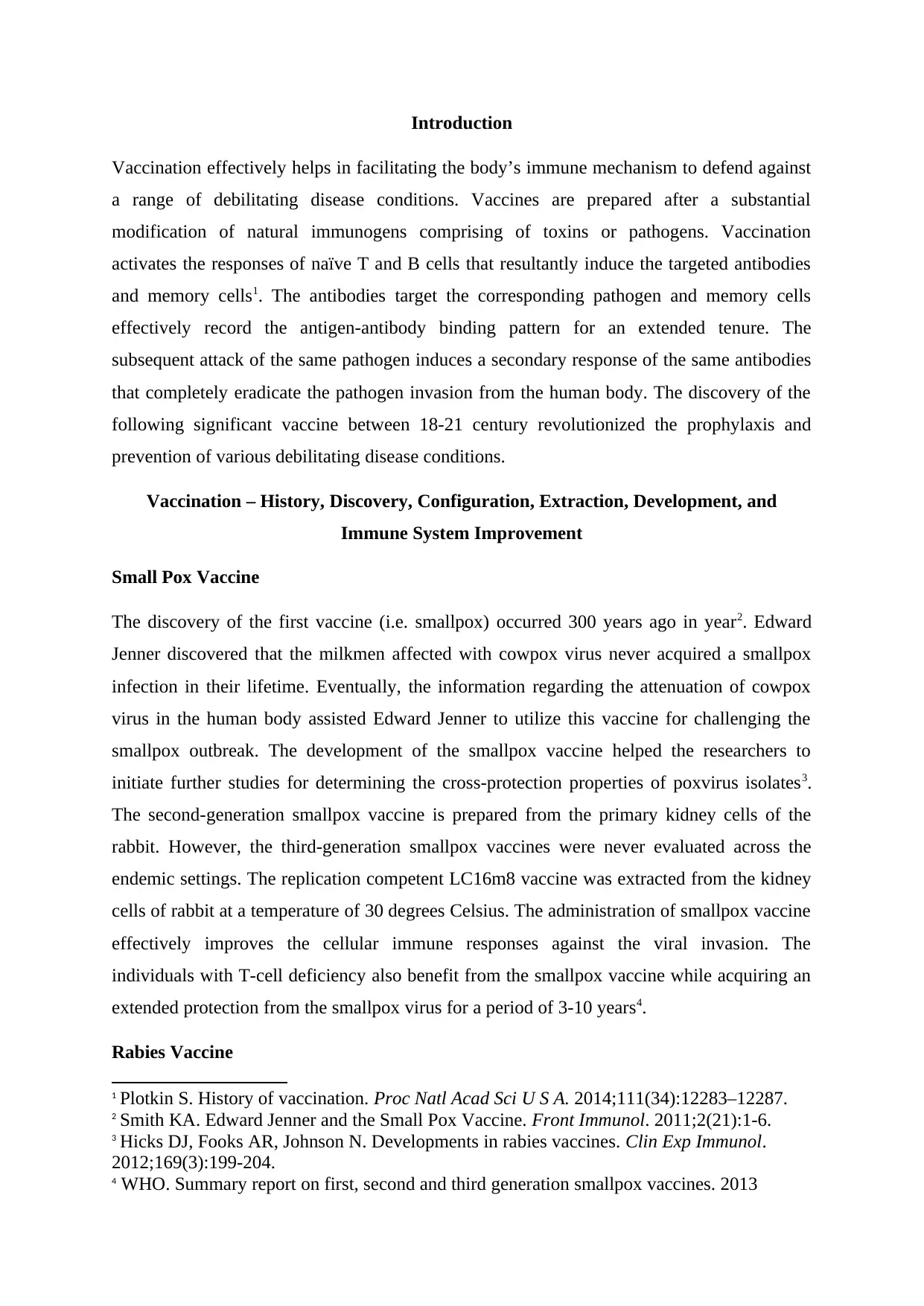
Introduction
Vaccination effectively helps in facilitating the body’s immune mechanism to defend against
a range of debilitating disease conditions. Vaccines are prepared after a substantial
modification of natural immunogens comprising of toxins or pathogens. Vaccination
activates the responses of naïve T and B cells that resultantly induce the targeted antibodies
and memory cells1. The antibodies target the corresponding pathogen and memory cells
effectively record the antigen-antibody binding pattern for an extended tenure. The
subsequent attack of the same pathogen induces a secondary response of the same antibodies
that completely eradicate the pathogen invasion from the human body. The discovery of the
following significant vaccine between 18-21 century revolutionized the prophylaxis and
prevention of various debilitating disease conditions. 1
Vaccination – History, Discovery, Configuration, Extraction, Development, and
Immune System Improvement
Small Pox Vaccine
The discovery of the first vaccine (i.e. smallpox) occurred 300 years ago in year2. Edward
Jenner discovered that the milkmen affected with cowpox virus never acquired a smallpox
infection in their lifetime. Eventually, the information regarding the attenuation of cowpox
virus in the human body assisted Edward Jenner to utilize this vaccine for challenging the
smallpox outbreak. The development of the smallpox vaccine helped the researchers to
initiate further studies for determining the cross-protection properties of poxvirus isolates3.
The second-generation smallpox vaccine is prepared from the primary kidney cells of the
rabbit. However, the third-generation smallpox vaccines were never evaluated across the
endemic settings. The replication competent LC16m8 vaccine was extracted from the kidney
cells of rabbit at a temperature of 30 degrees Celsius. The administration of smallpox vaccine
effectively improves the cellular immune responses against the viral invasion. The
individuals with T-cell deficiency also benefit from the smallpox vaccine while acquiring an
extended protection from the smallpox virus for a period of 3-10 years4.
Rabies Vaccine
1 Plotkin S. History of vaccination. Proc Natl Acad Sci U S A. 2014;111(34):12283–12287.
2 Smith KA. Edward Jenner and the Small Pox Vaccine. Front Immunol. 2011;2(21):1-6.
3 Hicks DJ, Fooks AR, Johnson N. Developments in rabies vaccines. Clin Exp Immunol.
2012;169(3):199-204.
4 WHO. Summary report on first, second and third generation smallpox vaccines. 2013
Vaccination effectively helps in facilitating the body’s immune mechanism to defend against
a range of debilitating disease conditions. Vaccines are prepared after a substantial
modification of natural immunogens comprising of toxins or pathogens. Vaccination
activates the responses of naïve T and B cells that resultantly induce the targeted antibodies
and memory cells1. The antibodies target the corresponding pathogen and memory cells
effectively record the antigen-antibody binding pattern for an extended tenure. The
subsequent attack of the same pathogen induces a secondary response of the same antibodies
that completely eradicate the pathogen invasion from the human body. The discovery of the
following significant vaccine between 18-21 century revolutionized the prophylaxis and
prevention of various debilitating disease conditions. 1
Vaccination – History, Discovery, Configuration, Extraction, Development, and
Immune System Improvement
Small Pox Vaccine
The discovery of the first vaccine (i.e. smallpox) occurred 300 years ago in year2. Edward
Jenner discovered that the milkmen affected with cowpox virus never acquired a smallpox
infection in their lifetime. Eventually, the information regarding the attenuation of cowpox
virus in the human body assisted Edward Jenner to utilize this vaccine for challenging the
smallpox outbreak. The development of the smallpox vaccine helped the researchers to
initiate further studies for determining the cross-protection properties of poxvirus isolates3.
The second-generation smallpox vaccine is prepared from the primary kidney cells of the
rabbit. However, the third-generation smallpox vaccines were never evaluated across the
endemic settings. The replication competent LC16m8 vaccine was extracted from the kidney
cells of rabbit at a temperature of 30 degrees Celsius. The administration of smallpox vaccine
effectively improves the cellular immune responses against the viral invasion. The
individuals with T-cell deficiency also benefit from the smallpox vaccine while acquiring an
extended protection from the smallpox virus for a period of 3-10 years4.
Rabies Vaccine
1 Plotkin S. History of vaccination. Proc Natl Acad Sci U S A. 2014;111(34):12283–12287.
2 Smith KA. Edward Jenner and the Small Pox Vaccine. Front Immunol. 2011;2(21):1-6.
3 Hicks DJ, Fooks AR, Johnson N. Developments in rabies vaccines. Clin Exp Immunol.
2012;169(3):199-204.
4 WHO. Summary report on first, second and third generation smallpox vaccines. 2013
Secure Best Marks with AI Grader
Need help grading? Try our AI Grader for instant feedback on your assignments.
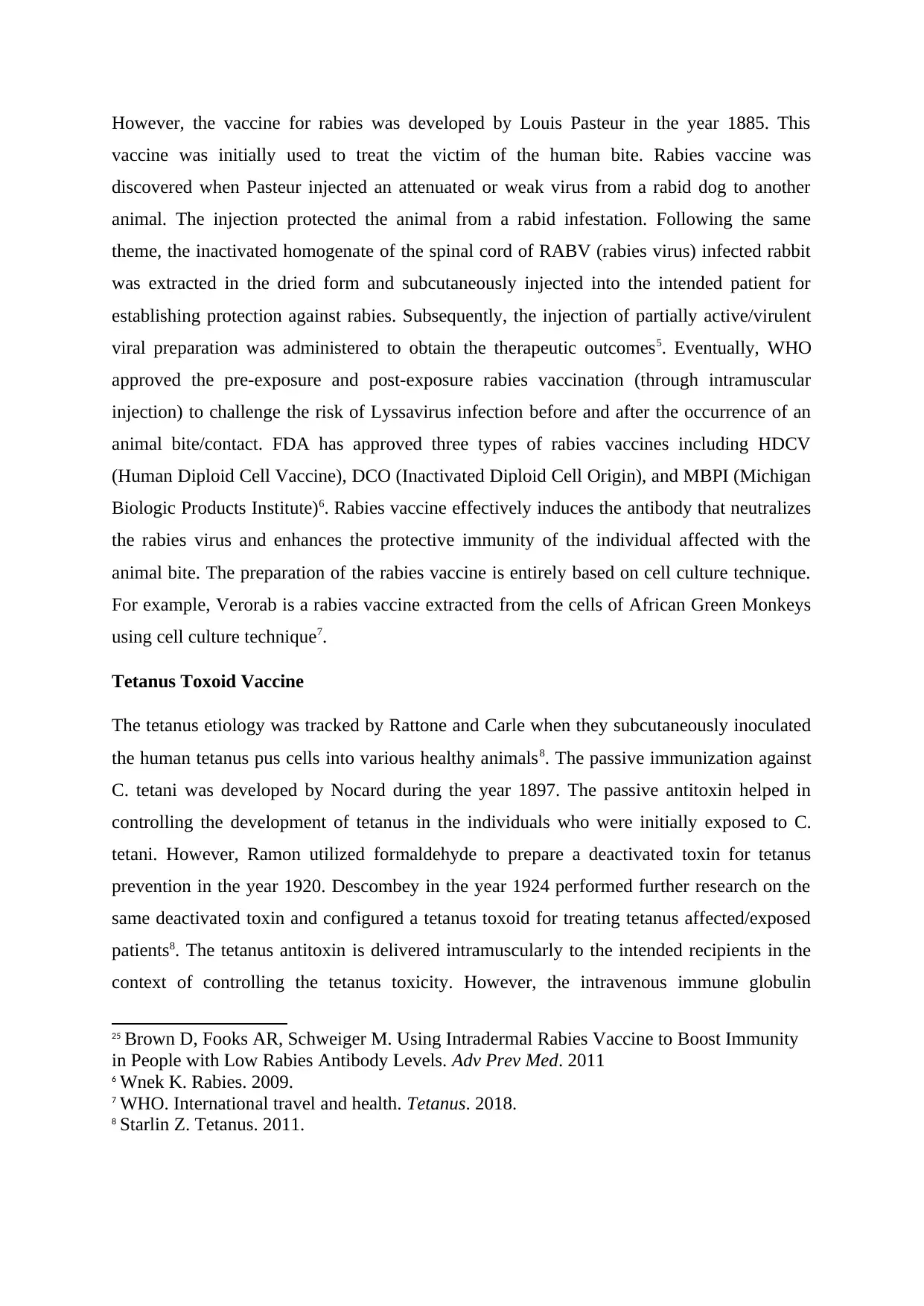
However, the vaccine for rabies was developed by Louis Pasteur in the year 1885. This
vaccine was initially used to treat the victim of the human bite. Rabies vaccine was
discovered when Pasteur injected an attenuated or weak virus from a rabid dog to another
animal. The injection protected the animal from a rabid infestation. Following the same
theme, the inactivated homogenate of the spinal cord of RABV (rabies virus) infected rabbit
was extracted in the dried form and subcutaneously injected into the intended patient for
establishing protection against rabies. Subsequently, the injection of partially active/virulent
viral preparation was administered to obtain the therapeutic outcomes5. Eventually, WHO
approved the pre-exposure and post-exposure rabies vaccination (through intramuscular
injection) to challenge the risk of Lyssavirus infection before and after the occurrence of an
animal bite/contact. FDA has approved three types of rabies vaccines including HDCV
(Human Diploid Cell Vaccine), DCO (Inactivated Diploid Cell Origin), and MBPI (Michigan
Biologic Products Institute)6. Rabies vaccine effectively induces the antibody that neutralizes
the rabies virus and enhances the protective immunity of the individual affected with the
animal bite. The preparation of the rabies vaccine is entirely based on cell culture technique.
For example, Verorab is a rabies vaccine extracted from the cells of African Green Monkeys
using cell culture technique7. 2
Tetanus Toxoid Vaccine
The tetanus etiology was tracked by Rattone and Carle when they subcutaneously inoculated
the human tetanus pus cells into various healthy animals8. The passive immunization against
C. tetani was developed by Nocard during the year 1897. The passive antitoxin helped in
controlling the development of tetanus in the individuals who were initially exposed to C.
tetani. However, Ramon utilized formaldehyde to prepare a deactivated toxin for tetanus
prevention in the year 1920. Descombey in the year 1924 performed further research on the
same deactivated toxin and configured a tetanus toxoid for treating tetanus affected/exposed
patients8. The tetanus antitoxin is delivered intramuscularly to the intended recipients in the
context of controlling the tetanus toxicity. However, the intravenous immune globulin
25 Brown D, Fooks AR, Schweiger M. Using Intradermal Rabies Vaccine to Boost Immunity
in People with Low Rabies Antibody Levels. Adv Prev Med. 2011
6 Wnek K. Rabies. 2009.
7 WHO. International travel and health. Tetanus. 2018.
8 Starlin Z. Tetanus. 2011.
vaccine was initially used to treat the victim of the human bite. Rabies vaccine was
discovered when Pasteur injected an attenuated or weak virus from a rabid dog to another
animal. The injection protected the animal from a rabid infestation. Following the same
theme, the inactivated homogenate of the spinal cord of RABV (rabies virus) infected rabbit
was extracted in the dried form and subcutaneously injected into the intended patient for
establishing protection against rabies. Subsequently, the injection of partially active/virulent
viral preparation was administered to obtain the therapeutic outcomes5. Eventually, WHO
approved the pre-exposure and post-exposure rabies vaccination (through intramuscular
injection) to challenge the risk of Lyssavirus infection before and after the occurrence of an
animal bite/contact. FDA has approved three types of rabies vaccines including HDCV
(Human Diploid Cell Vaccine), DCO (Inactivated Diploid Cell Origin), and MBPI (Michigan
Biologic Products Institute)6. Rabies vaccine effectively induces the antibody that neutralizes
the rabies virus and enhances the protective immunity of the individual affected with the
animal bite. The preparation of the rabies vaccine is entirely based on cell culture technique.
For example, Verorab is a rabies vaccine extracted from the cells of African Green Monkeys
using cell culture technique7. 2
Tetanus Toxoid Vaccine
The tetanus etiology was tracked by Rattone and Carle when they subcutaneously inoculated
the human tetanus pus cells into various healthy animals8. The passive immunization against
C. tetani was developed by Nocard during the year 1897. The passive antitoxin helped in
controlling the development of tetanus in the individuals who were initially exposed to C.
tetani. However, Ramon utilized formaldehyde to prepare a deactivated toxin for tetanus
prevention in the year 1920. Descombey in the year 1924 performed further research on the
same deactivated toxin and configured a tetanus toxoid for treating tetanus affected/exposed
patients8. The tetanus antitoxin is delivered intramuscularly to the intended recipients in the
context of controlling the tetanus toxicity. However, the intravenous immune globulin
25 Brown D, Fooks AR, Schweiger M. Using Intradermal Rabies Vaccine to Boost Immunity
in People with Low Rabies Antibody Levels. Adv Prev Med. 2011
6 Wnek K. Rabies. 2009.
7 WHO. International travel and health. Tetanus. 2018.
8 Starlin Z. Tetanus. 2011.
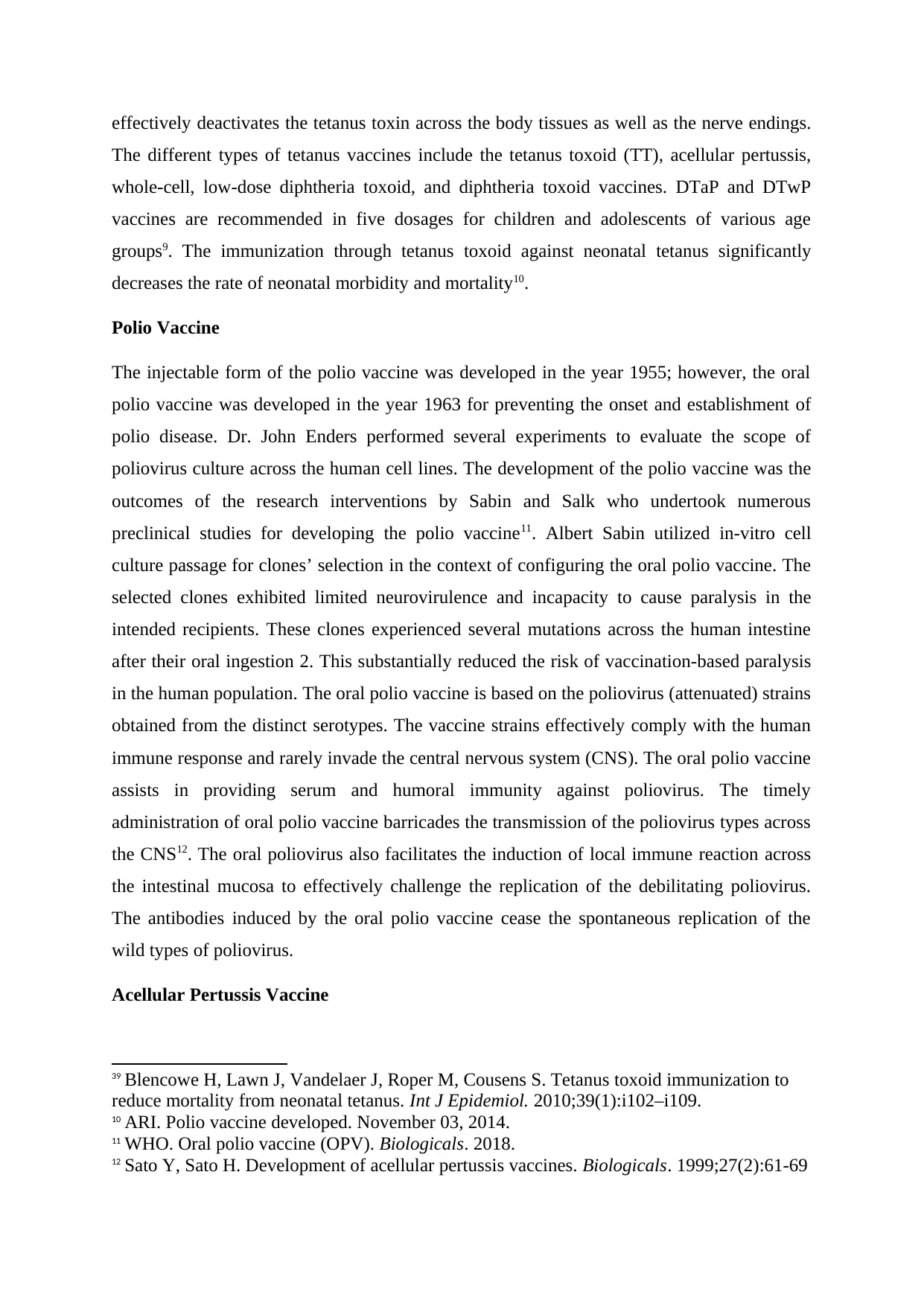
effectively deactivates the tetanus toxin across the body tissues as well as the nerve endings.
The different types of tetanus vaccines include the tetanus toxoid (TT), acellular pertussis,
whole-cell, low-dose diphtheria toxoid, and diphtheria toxoid vaccines. DTaP and DTwP
vaccines are recommended in five dosages for children and adolescents of various age
groups9. The immunization through tetanus toxoid against neonatal tetanus significantly
decreases the rate of neonatal morbidity and mortality10.
Polio Vaccine 3
The injectable form of the polio vaccine was developed in the year 1955; however, the oral
polio vaccine was developed in the year 1963 for preventing the onset and establishment of
polio disease. Dr. John Enders performed several experiments to evaluate the scope of
poliovirus culture across the human cell lines. The development of the polio vaccine was the
outcomes of the research interventions by Sabin and Salk who undertook numerous
preclinical studies for developing the polio vaccine11. Albert Sabin utilized in-vitro cell
culture passage for clones’ selection in the context of configuring the oral polio vaccine. The
selected clones exhibited limited neurovirulence and incapacity to cause paralysis in the
intended recipients. These clones experienced several mutations across the human intestine
after their oral ingestion 2. This substantially reduced the risk of vaccination-based paralysis
in the human population. The oral polio vaccine is based on the poliovirus (attenuated) strains
obtained from the distinct serotypes. The vaccine strains effectively comply with the human
immune response and rarely invade the central nervous system (CNS). The oral polio vaccine
assists in providing serum and humoral immunity against poliovirus. The timely
administration of oral polio vaccine barricades the transmission of the poliovirus types across
the CNS12. The oral poliovirus also facilitates the induction of local immune reaction across
the intestinal mucosa to effectively challenge the replication of the debilitating poliovirus.
The antibodies induced by the oral polio vaccine cease the spontaneous replication of the
wild types of poliovirus.
Acellular Pertussis Vaccine
39 Blencowe H, Lawn J, Vandelaer J, Roper M, Cousens S. Tetanus toxoid immunization to
reduce mortality from neonatal tetanus. Int J Epidemiol. 2010;39(1):i102–i109.
10 ARI. Polio vaccine developed. November 03, 2014.
11 WHO. Oral polio vaccine (OPV). Biologicals. 2018.
12 Sato Y, Sato H. Development of acellular pertussis vaccines. Biologicals. 1999;27(2):61-69
The different types of tetanus vaccines include the tetanus toxoid (TT), acellular pertussis,
whole-cell, low-dose diphtheria toxoid, and diphtheria toxoid vaccines. DTaP and DTwP
vaccines are recommended in five dosages for children and adolescents of various age
groups9. The immunization through tetanus toxoid against neonatal tetanus significantly
decreases the rate of neonatal morbidity and mortality10.
Polio Vaccine 3
The injectable form of the polio vaccine was developed in the year 1955; however, the oral
polio vaccine was developed in the year 1963 for preventing the onset and establishment of
polio disease. Dr. John Enders performed several experiments to evaluate the scope of
poliovirus culture across the human cell lines. The development of the polio vaccine was the
outcomes of the research interventions by Sabin and Salk who undertook numerous
preclinical studies for developing the polio vaccine11. Albert Sabin utilized in-vitro cell
culture passage for clones’ selection in the context of configuring the oral polio vaccine. The
selected clones exhibited limited neurovirulence and incapacity to cause paralysis in the
intended recipients. These clones experienced several mutations across the human intestine
after their oral ingestion 2. This substantially reduced the risk of vaccination-based paralysis
in the human population. The oral polio vaccine is based on the poliovirus (attenuated) strains
obtained from the distinct serotypes. The vaccine strains effectively comply with the human
immune response and rarely invade the central nervous system (CNS). The oral polio vaccine
assists in providing serum and humoral immunity against poliovirus. The timely
administration of oral polio vaccine barricades the transmission of the poliovirus types across
the CNS12. The oral poliovirus also facilitates the induction of local immune reaction across
the intestinal mucosa to effectively challenge the replication of the debilitating poliovirus.
The antibodies induced by the oral polio vaccine cease the spontaneous replication of the
wild types of poliovirus.
Acellular Pertussis Vaccine
39 Blencowe H, Lawn J, Vandelaer J, Roper M, Cousens S. Tetanus toxoid immunization to
reduce mortality from neonatal tetanus. Int J Epidemiol. 2010;39(1):i102–i109.
10 ARI. Polio vaccine developed. November 03, 2014.
11 WHO. Oral polio vaccine (OPV). Biologicals. 2018.
12 Sato Y, Sato H. Development of acellular pertussis vaccines. Biologicals. 1999;27(2):61-69
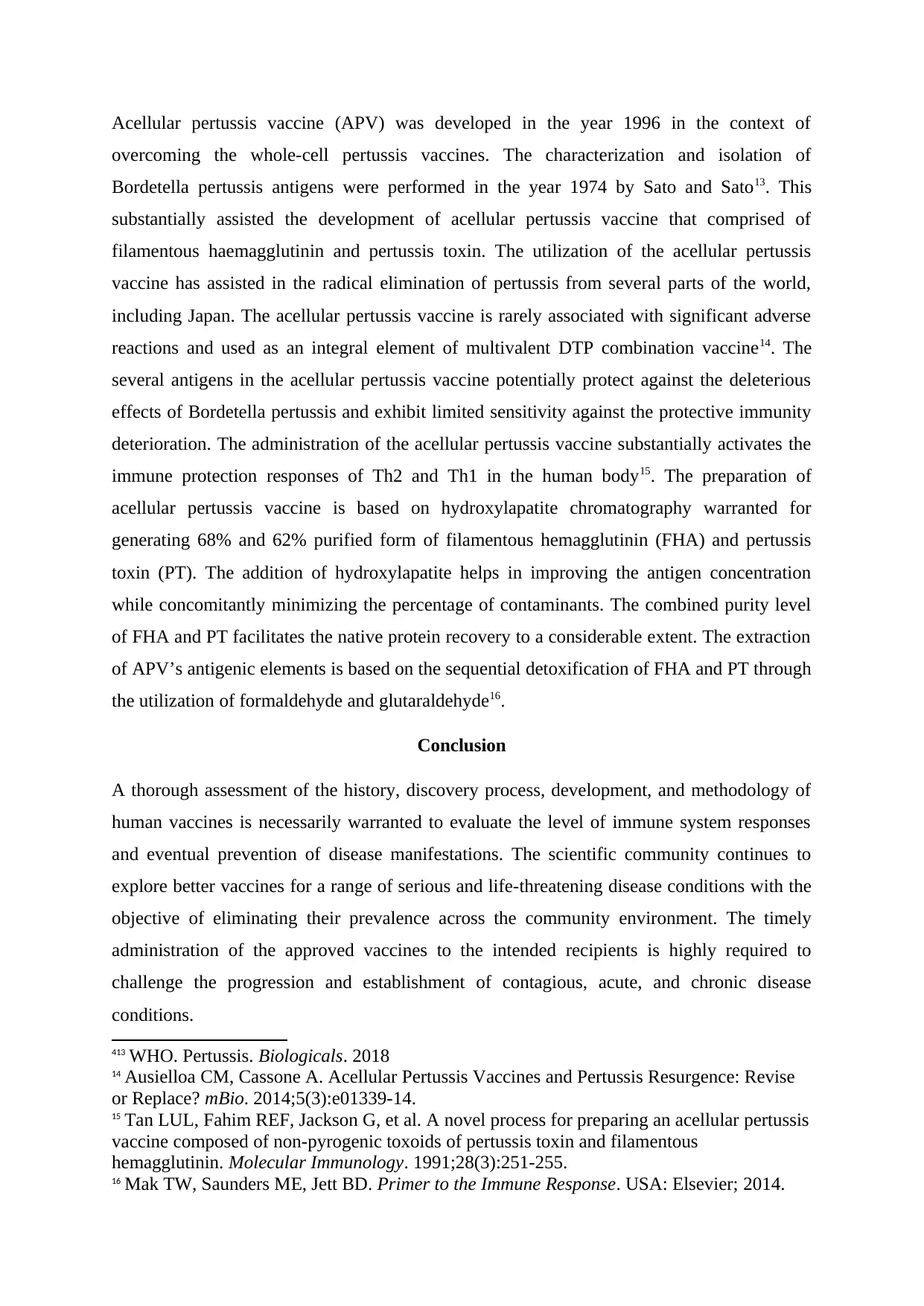
Acellular pertussis vaccine (APV) was developed in the year 1996 in the context of
overcoming the whole-cell pertussis vaccines. The characterization and isolation of
Bordetella pertussis antigens were performed in the year 1974 by Sato and Sato13. This
substantially assisted the development of acellular pertussis vaccine that comprised of
filamentous haemagglutinin and pertussis toxin. The utilization of the acellular pertussis
vaccine has assisted in the radical elimination of pertussis from several parts of the world,
including Japan. The acellular pertussis vaccine is rarely associated with significant adverse
reactions and used as an integral element of multivalent DTP combination vaccine14. The
several antigens in the acellular pertussis vaccine potentially protect against the deleterious
effects of Bordetella pertussis and exhibit limited sensitivity against the protective immunity
deterioration. The administration of the acellular pertussis vaccine substantially activates the
immune protection responses of Th2 and Th1 in the human body15. The preparation of
acellular pertussis vaccine is based on hydroxylapatite chromatography warranted for
generating 68% and 62% purified form of filamentous hemagglutinin (FHA) and pertussis
toxin (PT). The addition of hydroxylapatite helps in improving the antigen concentration
while concomitantly minimizing the percentage of contaminants. The combined purity level
of FHA and PT facilitates the native protein recovery to a considerable extent. The extraction
of APV’s antigenic elements is based on the sequential detoxification of FHA and PT through
the utilization of formaldehyde and glutaraldehyde16. 4
Conclusion
A thorough assessment of the history, discovery process, development, and methodology of
human vaccines is necessarily warranted to evaluate the level of immune system responses
and eventual prevention of disease manifestations. The scientific community continues to
explore better vaccines for a range of serious and life-threatening disease conditions with the
objective of eliminating their prevalence across the community environment. The timely
administration of the approved vaccines to the intended recipients is highly required to
challenge the progression and establishment of contagious, acute, and chronic disease
conditions.
413 WHO. Pertussis. Biologicals. 2018
14 Ausielloa CM, Cassone A. Acellular Pertussis Vaccines and Pertussis Resurgence: Revise
or Replace? mBio. 2014;5(3):e01339-14.
15 Tan LUL, Fahim REF, Jackson G, et al. A novel process for preparing an acellular pertussis
vaccine composed of non-pyrogenic toxoids of pertussis toxin and filamentous
hemagglutinin. Molecular Immunology. 1991;28(3):251-255.
16 Mak TW, Saunders ME, Jett BD. Primer to the Immune Response. USA: Elsevier; 2014.
overcoming the whole-cell pertussis vaccines. The characterization and isolation of
Bordetella pertussis antigens were performed in the year 1974 by Sato and Sato13. This
substantially assisted the development of acellular pertussis vaccine that comprised of
filamentous haemagglutinin and pertussis toxin. The utilization of the acellular pertussis
vaccine has assisted in the radical elimination of pertussis from several parts of the world,
including Japan. The acellular pertussis vaccine is rarely associated with significant adverse
reactions and used as an integral element of multivalent DTP combination vaccine14. The
several antigens in the acellular pertussis vaccine potentially protect against the deleterious
effects of Bordetella pertussis and exhibit limited sensitivity against the protective immunity
deterioration. The administration of the acellular pertussis vaccine substantially activates the
immune protection responses of Th2 and Th1 in the human body15. The preparation of
acellular pertussis vaccine is based on hydroxylapatite chromatography warranted for
generating 68% and 62% purified form of filamentous hemagglutinin (FHA) and pertussis
toxin (PT). The addition of hydroxylapatite helps in improving the antigen concentration
while concomitantly minimizing the percentage of contaminants. The combined purity level
of FHA and PT facilitates the native protein recovery to a considerable extent. The extraction
of APV’s antigenic elements is based on the sequential detoxification of FHA and PT through
the utilization of formaldehyde and glutaraldehyde16. 4
Conclusion
A thorough assessment of the history, discovery process, development, and methodology of
human vaccines is necessarily warranted to evaluate the level of immune system responses
and eventual prevention of disease manifestations. The scientific community continues to
explore better vaccines for a range of serious and life-threatening disease conditions with the
objective of eliminating their prevalence across the community environment. The timely
administration of the approved vaccines to the intended recipients is highly required to
challenge the progression and establishment of contagious, acute, and chronic disease
conditions.
413 WHO. Pertussis. Biologicals. 2018
14 Ausielloa CM, Cassone A. Acellular Pertussis Vaccines and Pertussis Resurgence: Revise
or Replace? mBio. 2014;5(3):e01339-14.
15 Tan LUL, Fahim REF, Jackson G, et al. A novel process for preparing an acellular pertussis
vaccine composed of non-pyrogenic toxoids of pertussis toxin and filamentous
hemagglutinin. Molecular Immunology. 1991;28(3):251-255.
16 Mak TW, Saunders ME, Jett BD. Primer to the Immune Response. USA: Elsevier; 2014.
Secure Best Marks with AI Grader
Need help grading? Try our AI Grader for instant feedback on your assignments.
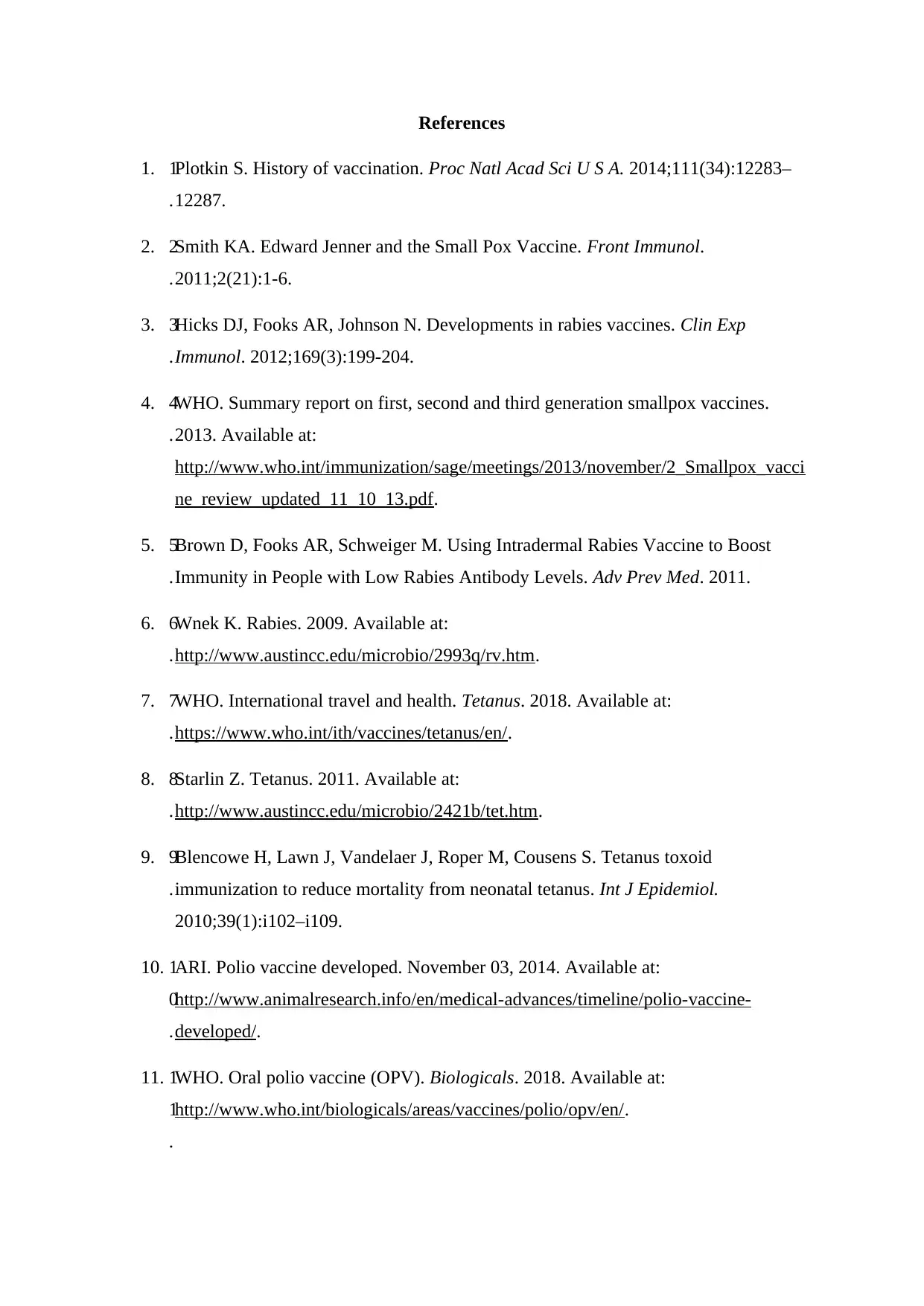
References
1. 1
.
Plotkin S. History of vaccination. Proc Natl Acad Sci U S A. 2014;111(34):12283–
12287.
2. 2
.
Smith KA. Edward Jenner and the Small Pox Vaccine. Front Immunol.
2011;2(21):1-6.
3. 3
.
Hicks DJ, Fooks AR, Johnson N. Developments in rabies vaccines. Clin Exp
Immunol. 2012;169(3):199-204.
4. 4
.
WHO. Summary report on first, second and third generation smallpox vaccines.
2013. Available at:
http://www.who.int/immunization/sage/meetings/2013/november/2_Smallpox_vacci
ne_review_updated_11_10_13.pdf.
5. 5
.
Brown D, Fooks AR, Schweiger M. Using Intradermal Rabies Vaccine to Boost
Immunity in People with Low Rabies Antibody Levels. Adv Prev Med. 2011.
6. 6
.
Wnek K. Rabies. 2009. Available at:
http://www.austincc.edu/microbio/2993q/rv.htm.
7. 7
.
WHO. International travel and health. Tetanus. 2018. Available at:
https://www.who.int/ith/vaccines/tetanus/en/.
8. 8
.
Starlin Z. Tetanus. 2011. Available at:
http://www.austincc.edu/microbio/2421b/tet.htm.
9. 9
.
Blencowe H, Lawn J, Vandelaer J, Roper M, Cousens S. Tetanus toxoid
immunization to reduce mortality from neonatal tetanus. Int J Epidemiol.
2010;39(1):i102–i109.
10. 1
0
.
ARI. Polio vaccine developed. November 03, 2014. Available at:
http://www.animalresearch.info/en/medical-advances/timeline/polio-vaccine-
developed/.
11. 1
1
.
WHO. Oral polio vaccine (OPV). Biologicals. 2018. Available at:
http://www.who.int/biologicals/areas/vaccines/polio/opv/en/.
1. 1
.
Plotkin S. History of vaccination. Proc Natl Acad Sci U S A. 2014;111(34):12283–
12287.
2. 2
.
Smith KA. Edward Jenner and the Small Pox Vaccine. Front Immunol.
2011;2(21):1-6.
3. 3
.
Hicks DJ, Fooks AR, Johnson N. Developments in rabies vaccines. Clin Exp
Immunol. 2012;169(3):199-204.
4. 4
.
WHO. Summary report on first, second and third generation smallpox vaccines.
2013. Available at:
http://www.who.int/immunization/sage/meetings/2013/november/2_Smallpox_vacci
ne_review_updated_11_10_13.pdf.
5. 5
.
Brown D, Fooks AR, Schweiger M. Using Intradermal Rabies Vaccine to Boost
Immunity in People with Low Rabies Antibody Levels. Adv Prev Med. 2011.
6. 6
.
Wnek K. Rabies. 2009. Available at:
http://www.austincc.edu/microbio/2993q/rv.htm.
7. 7
.
WHO. International travel and health. Tetanus. 2018. Available at:
https://www.who.int/ith/vaccines/tetanus/en/.
8. 8
.
Starlin Z. Tetanus. 2011. Available at:
http://www.austincc.edu/microbio/2421b/tet.htm.
9. 9
.
Blencowe H, Lawn J, Vandelaer J, Roper M, Cousens S. Tetanus toxoid
immunization to reduce mortality from neonatal tetanus. Int J Epidemiol.
2010;39(1):i102–i109.
10. 1
0
.
ARI. Polio vaccine developed. November 03, 2014. Available at:
http://www.animalresearch.info/en/medical-advances/timeline/polio-vaccine-
developed/.
11. 1
1
.
WHO. Oral polio vaccine (OPV). Biologicals. 2018. Available at:
http://www.who.int/biologicals/areas/vaccines/polio/opv/en/.
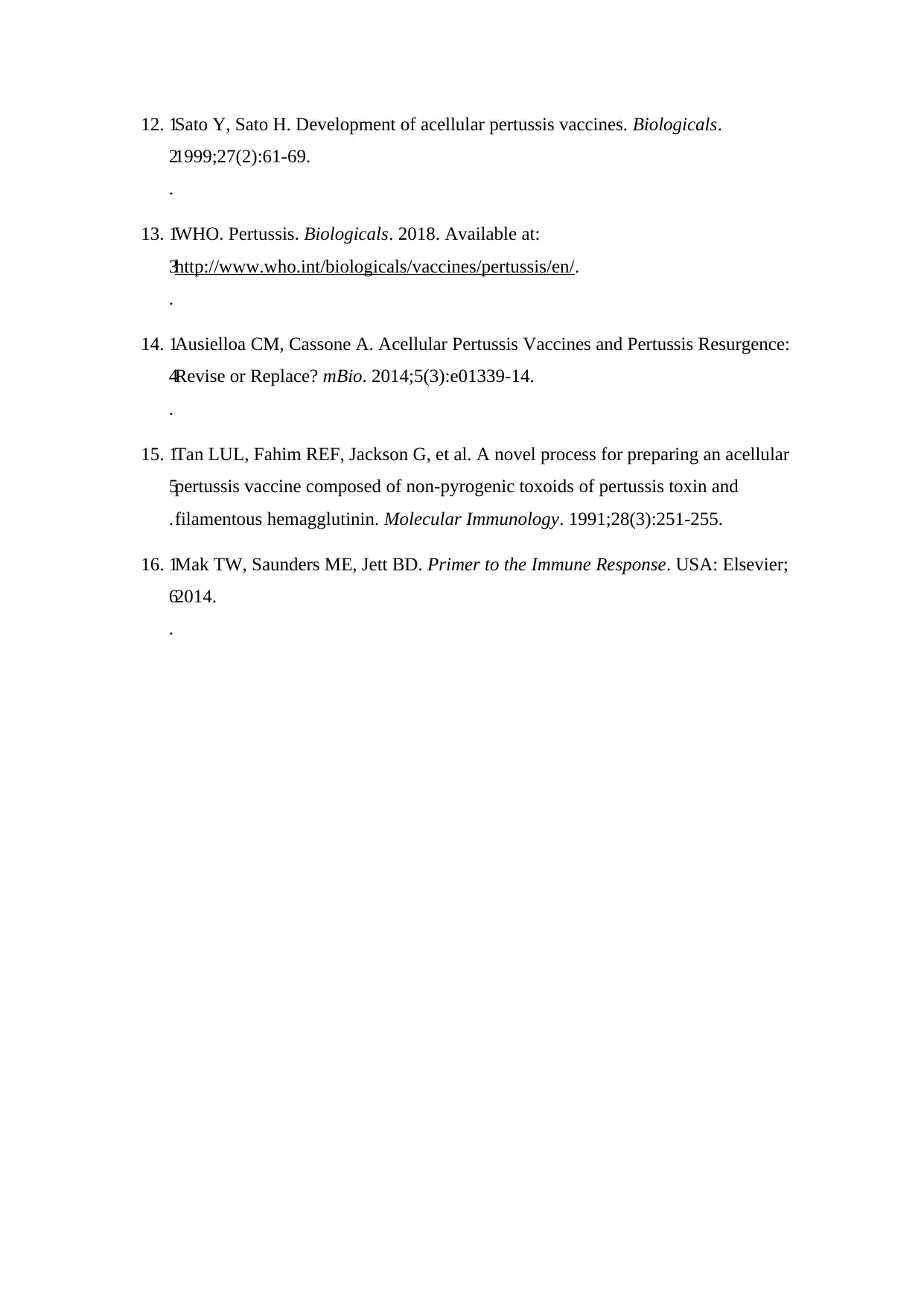
12. 1
2
.
Sato Y, Sato H. Development of acellular pertussis vaccines. Biologicals.
1999;27(2):61-69.
13. 1
3
.
WHO. Pertussis. Biologicals. 2018. Available at:
http://www.who.int/biologicals/vaccines/pertussis/en/.
14. 1
4
.
Ausielloa CM, Cassone A. Acellular Pertussis Vaccines and Pertussis Resurgence:
Revise or Replace? mBio. 2014;5(3):e01339-14.
15. 1
5
.
Tan LUL, Fahim REF, Jackson G, et al. A novel process for preparing an acellular
pertussis vaccine composed of non-pyrogenic toxoids of pertussis toxin and
filamentous hemagglutinin. Molecular Immunology. 1991;28(3):251-255.
16. 1
6
.
Mak TW, Saunders ME, Jett BD. Primer to the Immune Response. USA: Elsevier;
2014.
2
.
Sato Y, Sato H. Development of acellular pertussis vaccines. Biologicals.
1999;27(2):61-69.
13. 1
3
.
WHO. Pertussis. Biologicals. 2018. Available at:
http://www.who.int/biologicals/vaccines/pertussis/en/.
14. 1
4
.
Ausielloa CM, Cassone A. Acellular Pertussis Vaccines and Pertussis Resurgence:
Revise or Replace? mBio. 2014;5(3):e01339-14.
15. 1
5
.
Tan LUL, Fahim REF, Jackson G, et al. A novel process for preparing an acellular
pertussis vaccine composed of non-pyrogenic toxoids of pertussis toxin and
filamentous hemagglutinin. Molecular Immunology. 1991;28(3):251-255.
16. 1
6
.
Mak TW, Saunders ME, Jett BD. Primer to the Immune Response. USA: Elsevier;
2014.
1 out of 6
Related Documents
Your All-in-One AI-Powered Toolkit for Academic Success.
+13062052269
info@desklib.com
Available 24*7 on WhatsApp / Email
![[object Object]](/_next/static/media/star-bottom.7253800d.svg)
Unlock your academic potential
© 2024 | Zucol Services PVT LTD | All rights reserved.





